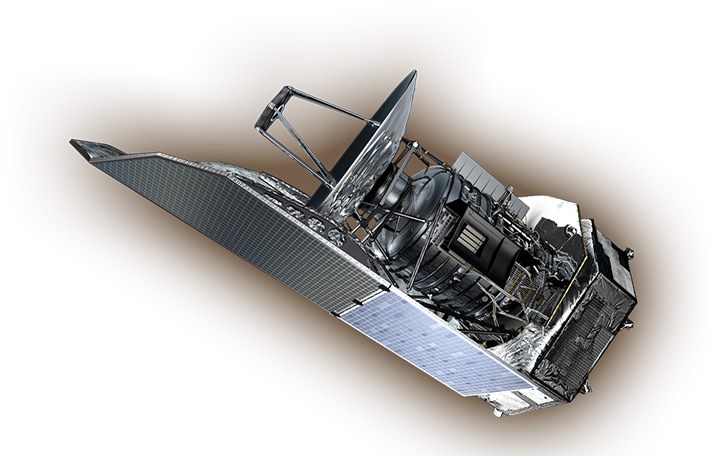Why Observe in the Far IR and Submillimeter?
Beyond the Rainbow
Remember the first time you saw "The Wizard of Oz," and the drab black-and-white of Kansas changed to the dazzling full color of Munchkinland? Imagine if landing in Oz also enabled you to see colors that no human eye had ever been able to detect - and these new colors revealed fantastic objects that had previously been invisible!
That is what it was like when astronomers began observing in the infrared.
In fact, some of the most interesting things in the Universe are visible only in light beyond the rainbow of colors that people can see.

Radio waves, microwaves, x-rays, gamma rays, and the spectrum of visible colors are all really the same thing - electromagnetic energy. The differences are their wavelengths. Radio waves are long, measuring as much as hundreds of meters between peaks. Gamma ray wavelengths are extremely short, as little as trillionths of a meter. A photon of shorter-wavelength light packs more energy than a photon of longer-wavelength light.
Within the limited range our eyes can perceive, we interpret different wavelengths as colors, from violet (about 400 nanometers) to red (about 700 nanometers). Light with wavelengths just shorter than violet is known as "ultraviolet" (UV). We can't see it (though some insects can), but our skin responds to it. That's the portion of sunlight we're trying to block when we wear sunscreen.
The part of the spectrum with wavelengths just longer than red is called "infrared" (IR). Like UV light, IR light is invisible to the naked eye. But we can feel it as heat, and we can see it with the aid of technology.
"Night vision" devices enable people to see by the light of the near-infrared, the wavelengths just beyond visible light. Instruments aboard the Herschel Space Observatory will enable us to see the far-infrared and submillimeter portion of the spectrum, from about 60 to 670 microns in wavelength.
Why is infrared radiation important to astronomy?
Most of the light in the Universe is in infrared and longer wavelengths. There are three basic reasons for this:
-
It's cold out there.
Many of the things scientists want to observe in space are far too cold to radiate at optical or shorter wavelengths. However, even at temperatures far below the coldest spots on Earth, they do radiate at far-infrared and submillimeter wavelengths.
To understand how stars form and evolve, we need to understand their raw materials - the cold atoms and molecules that populate interstellar space. They radiate most strongly in Herschel's range. Analyzing their spectra will enable scientists to determine the temperature, density, luminosity, composition, magnetic fields, and dynamics of the chemicals and their environments.
In our own solar system, cold objects such as comets, asteroids, and the planets themselves reveal most of their characteristics by infrared light.
Brown dwarfs, protostars, dusty disks around young stars, and planets in other star systems are all too cold to radiate in the optical range, but shine at infrared wavelengths. (The stars will outshine their planets in the IR, but the relative glare is much less in the infrared.)
-
It's dusty out there.
A number of things of great interest to astronomy are hidden within or behind vast clouds of gas and dust. In the early stages of forming, stars and planets are concealed by the stuff. So are the enormously powerful cores of active galaxies, the center of our own Milky Way, and most of the early Universe.
Our view is blocked in visible light because the dust grains are about the same size as optical wavelengths, about one micron or less, and so are very effective at scattering or absorbing that light. But longer infrared wavelengths undulate around the dust. And the longer the wavelength, the thicker the layer of dust it can penetrate. So far-IR and submillimeter radiation can move freely through the Universe, unobstructed by dust.
The visible and ultraviolet light that the dust absorbs warms the grains just enough for them to reradiate the light at infrared wavelengths. So in addition to allowing infrared light to pass through, the dust itself radiates at that range of wavelengths. And by analyzing the dust's radiation, scientists can deduce information about the optical sources it is hiding.
-
The Universe is expanding.
Galaxies outside our own group are traveling away from us with the expansion of the universe, and the more distant they are, the faster they're receding. As they speed away, their light is "redshifted" to longer wavelengths. Light that starts out at optical wavelengths may be stretched into the infrared.
What Infrared Astronomy has shown us so far?
Optical astronomy has been around since the first humans looked up and started to chart the motions of the heavens. We've boosted our powers of observation with instruments since 1609, when Galileo pointed a telescope at the moon. But it is only within the last half-century that we have begun to explore the Universe in the infrared. And the results have been astonishing.
The first infrared survey of the sky, published in 1965, revealed ten objects that optical telescopes couldn't see. By 1969, thousands of new objects had been discovered in the infrared.
More recently, infrared astronomy made the surprising discovery that Jupiter, Saturn, and Neptune have internal sources of heat. It found a hundred thousand red giant stars in the central bulge of the Milky Way, and ices of water, methane, carbon dioxide, formaldehyde, and carbon monoxide in interstellar space.
Old, familiar objects have revealed new features by the light of the infrared. By optical light (left), the Andromeda galaxy appears as a spiral that grows more tenuous at the outer regions. But in the infrared (right), we can see that a giant ring of dust at the outskirts of the galaxy is a hotbed of star formation.

Infrared observations of galaxies 10 billion light years away found star-formation at a rate three to four times greater than optical surveys had indicated, dramatically changing our understanding of the early Universe.
Deeper into the Infrared and Submillimeter
Herschel's observations of far-IR and submillimeter light promised to reveal even more wonders.
At these wavelengths, Herschel was able to probe deeper into dusty interstellar nurseries to see details of star formation that have so far remained hidden. It had a much clearer view of our galaxy's core, as well as the centers of neighboring galaxies. And it peered through massive dusty toroids for an unprecedented look at the cosmic powerhouses known as Active Galactic Nuclei.
This is also the best part of the electromagnetic spectrum for observing key chemicals in space. About 130 kinds of chemicals have been detected so far in the interstellar medium, and most have rotational spectra - the photon emissions induced by the rotation of the molecules - with wavelengths that peak in the submillimeter range. These include the many forms of water and the organic molecules thought to be necessary for life.
Herschel uncovered new information about how these chemicals come to be, their role in the life cycles of stars and galaxies, and how they work in the atmospheres of our neighboring planets and comets.
And finally, this is the optimal range for observing the earliest, most distant galaxies whose light has been redshifted into wavelengths too long even for Herschel's predecessor, the Infrared Space Observatory, to detect. But Herschel was able see light from this era, when the Universe was just coming out of its "Dark Age," and the first galaxies were beginning to form.
To Learn More
Caltech / IPAC offers tutorials to help you learn more about Infrared Astronomy and Infrared Spectroscopy.







